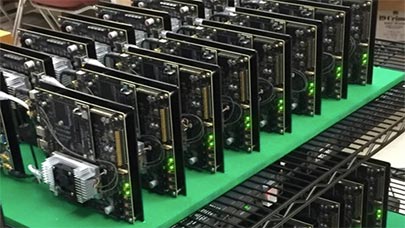
Alternative Supercomputing or How to Misuse a Computer
July 14, 2016
In 2008, the IBM Roadrunner supercomputer broke the petaflops barrier using the power of the heterogeneous Sony Cell Broadband Engine (BE) processor. A year prior, the Cell BE had already made its way into the consumer market as the engine inside the SonyPlaystation 3. The PS3's accelerated design, Linux-capability and low price point... Read more…

Sony Removes Folding@home Service from PS3
October 22, 2012
After a successful five-year run, Sony is ending its participation with Stanford University's Folding@home project. Read more…

Air Force’s PS3 Condor Cluster Takes Flight
December 3, 2010
Where else can you get a half a petaflop of computing power for around $2 million? Read more…

Air Force May Suffer Collateral Damage from PS3 Firmware Update
May 13, 2010
Sony's decision to kill Linux on the PlayStation 3 is bad news for the Air Force's PS3 supercomputing cluster. Read more…

Homebrew HPC: Stomping On The PS3
March 31, 2010
Sony nixes Linux install on next firmware upgrade. Read more…

Sony Still Subsidizing US Military Supercomputer Efforts
November 30, 2009
DoD buys 2200 PlayStations to turbocharge cluster. Read more…

Interview with Dr. Gaurav Khanna, A Pioneer In The PS3 Supercomputing Field
October 6, 2009
An astrophysicist builds a PlayStation cluster. Read more…

- Click Here for More Headlines

Whitepaper
Transforming Industrial and Automotive Manufacturing
In this era, expansion in digital infrastructure capacity is inevitable. Parallel to this, climate change consciousness is also rising, making sustainability a mandatory part of the organization’s functioning. As computing workloads such as AI and HPC continue to surge, so does the energy consumption, posing environmental woes. IT departments within organizations have a crucial role in combating this challenge. They can significantly drive sustainable practices by influencing newer technologies and process adoption that aid in mitigating the effects of climate change.
While buying more sustainable IT solutions is an option, partnering with IT solutions providers, such and Lenovo and Intel, who are committed to sustainability and aiding customers in executing sustainability strategies is likely to be more impactful.
Learn how Lenovo and Intel, through their partnership, are strongly positioned to address this need with their innovations driving energy efficiency and environmental stewardship.
Download Now
Sponsored by Lenovo
Whitepaper
How Direct Liquid Cooling Improves Data Center Energy Efficiency
Data centers are experiencing increasing power consumption, space constraints and cooling demands due to the unprecedented computing power required by today’s chips and servers. HVAC cooling systems consume approximately 40% of a data center’s electricity. These systems traditionally use air conditioning, air handling and fans to cool the data center facility and IT equipment, ultimately resulting in high energy consumption and high carbon emissions. Data centers are moving to direct liquid cooled (DLC) systems to improve cooling efficiency thus lowering their PUE, operating expenses (OPEX) and carbon footprint.
This paper describes how CoolIT Systems (CoolIT) meets the need for improved energy efficiency in data centers and includes case studies that show how CoolIT’s DLC solutions improve energy efficiency, increase rack density, lower OPEX, and enable sustainability programs. CoolIT is the global market and innovation leader in scalable DLC solutions for the world’s most demanding computing environments. CoolIT’s end-to-end solutions meet the rising demand in cooling and the rising demand for energy efficiency.
Download Now
Sponsored by CoolIT
Advanced Scale Career Development & Workforce Enhancement Center
Featured Advanced Scale Jobs:
HPCwire Resource Library
HPCwire Product Showcase
© 2024 HPCwire. All Rights Reserved. A Tabor Communications Publication
HPCwire is a registered trademark of Tabor Communications, Inc. Use of this site is governed by our Terms of Use and Privacy Policy.
Reproduction in whole or in part in any form or medium without express written permission of Tabor Communications, Inc. is prohibited.
























